Содержание
- 2. Main themes 1) Poetry as a revelation of the mystery that surrounds reality 2) The voyant
- 3. In literature symbolism was an aesthetic movement which developed in the late 19th century; its manifesto
- 4. Symbolism in England had its most representative and influential poets in the early 20th century. William
- 5. Responding to the Realist movement, these poets believed that words cannot adequately express reality, thus, the
- 6. Realism had become a strong literary and artistic movement in the early 19th Century. "Realists" sought
- 7. Baudelaire Charles Baudelaire was a 19th century French poet, translator, and literary and art critic whose
- 8. Known for his highly controversial, and often dark poetry, as well as his translation of the
- 9. In his often introspective poetry, Baudelaire revealed himself as a seeker of God without religious beliefs,
- 10. Baudelaire's father died in February of 1827. Baudelaire and his mother lived together on the outskirts
- 11. Baudelaire began his education at the Collège Royal in Lyons when Aupick was posted there, transferring
- 12. Eventually Baudelaire became a nominal student of law at the École de Droit. In reality, he
- 13. Baudelaire met the mulatto woman known as Jeanne Duval, who, first as his mistress and then,
- 15. Les fleurs du mal (1857) In its final version (1861), Les fleurs du mal was made
- 16. The failure of Les fleurs du mal, from which he had expected so much, was a
- 17. Thanks to metaphor, the poet can establish some contacts among different elements. These connections are based
- 18. Structure of “Les Fleurs du Mal” “Spleen et Ideal”: men become aware of Ennui (anxiety)in front
- 19. “Le vin”: Escape in drunkenness. “Les Fleurs du mal”: Escape in the artificial paradise. “Révolte”: invocation
- 20. Beauty Conceive me as a dream of stone: my breast, where mortals come to grief, is
- 22. Скачать презентацию
Слайд 2Main themes
1) Poetry as a revelation of the mystery that surrounds reality
2)
Main themes
1) Poetry as a revelation of the mystery that surrounds reality
2)

3)The renewal of the expression: word-revelation, word-music, use of the analogy and of the symbol.
Слайд 3In literature symbolism was an aesthetic movement which developed in the late
In literature symbolism was an aesthetic movement which developed in the late

The most important statement of symbolist aesthetics, however, was Mallarmè’s “Divagations” (1897); although the symbolists didn’t adhere to a uniform doctrine, they recognised their precursors in Charles Baudelaire and his theory of the correspondences between the senses, in the poetics of Poe, in Wagner’s ideas of a synthesis of the arts, in Schopenhauer’s formula “the world is my idea”.
Symbolism was a manifestation of Hegel’s philosophy of idealism. Symbolists believed that the world perceived through the senses was reflection of the spiritual universe. Therefore the poem became a means to metaphysical knowledge. This is why many of them experimented with free verse.
Слайд 4Symbolism in England had its most representative and influential poets in the
Symbolism in England had its most representative and influential poets in the

Among American writers Emily Dickinson created a poetry endowed with a visionary quality aiming at a metaphysical tension towards the infinite.
It was only at the beginning of the 20th century that the influence of Symbolism could be traced in the works by Gabriele D’Annunzio and Giovanni Pascoli.
Слайд 5Responding to the Realist movement, these poets believed that words cannot adequately
Responding to the Realist movement, these poets believed that words cannot adequately

These Symbolists retained thematic commonalties in their works which included:
Life as an artist.
Questioning authority.
Life in Paris.
Primal lust.
Darkness.
Vampirism and blood.
Death.
Urban life.
Poet as a painter or musician.
Слайд 6Realism had become a strong literary and artistic movement in the early
Realism had become a strong literary and artistic movement in the early

These symbols were not made to be entirely cohesive, the focus was more on the pattern which the words together created. This construction of ideas not only described the world through new eyes, but also uncovered the complex layers of darkness and light in everyday life.
Слайд 7Baudelaire
Charles Baudelaire was a 19th century French poet, translator, and literary and
Baudelaire
Charles Baudelaire was a 19th century French poet, translator, and literary and

Слайд 8Known for his highly controversial, and often dark poetry, as well as
Known for his highly controversial, and often dark poetry, as well as

Long after his death many look upon his name as representing depravity and vice: others see him as being the poet of modern civilization, seeming to speak directly to the 20th century.
Слайд 9In his often introspective poetry, Baudelaire revealed himself as a seeker of
In his often introspective poetry, Baudelaire revealed himself as a seeker of

Baudelaire was an only child of François Baudelaire and his younger second wife whom he had married in 1819, Caroline Defayis. François had begun a career as a priest, but left the holy orders in 1793 to become a prosperous middle-ranking civil servant. Being a modestly talented poet and painter, he instilled an appreciation for the arts in his son. The younger Baudelaire would later refer to as "the cult of images."
Слайд 10Baudelaire's father died in February of 1827. Baudelaire and his mother lived
Baudelaire's father died in February of 1827. Baudelaire and his mother lived

This time together ended when Caroline married a career soldier named Jacques Aupick, who rose to the position of General and later served as French ambassador to the Ottoman Empire and Spain before becoming a senator under the Second Empire.
Слайд 11Baudelaire began his education at the Collège Royal in Lyons when Aupick
Baudelaire began his education at the Collège Royal in Lyons when Aupick

He began to write poems, which were not well received by his masters, who felt that was an example of precocious depravity, adopting affections that they deemed unsuited to his age. Moods of intense melancholy also developed and Baudelaire began to see himself as being solitary by nature. In April 1839 he was expelled from school due to his consistent acts of indiscipline.
Слайд 12Eventually Baudelaire became a nominal student of law at the École de
Eventually Baudelaire became a nominal student of law at the École de

In an attempt to draw his stepson away from the company he was keeping, Aupick sent him on a voyage to India in June of 1841. Baudelaire jumped ship in Mauritius and eventually made his way back to France in February of 1842. The voyage and his exploits after jumping ship enriched his imagination, and brought a rich mixture of exotic images to his work.
Baudelaire received his inheritance in April 1842 and rapidly proceeded to dissipate it on the lifestyle of a dandified man of letters, spending freely on clothes, books, paintings, expensive food and wines, and, not least, hashish and opium, which he first experimented with in his Paris apartment at the Hôtel Pimodan on the Île Saint-Louis between 1843 and 1845.
Слайд 13Baudelaire met the mulatto woman known as Jeanne Duval, who, first as
Baudelaire met the mulatto woman known as Jeanne Duval, who, first as
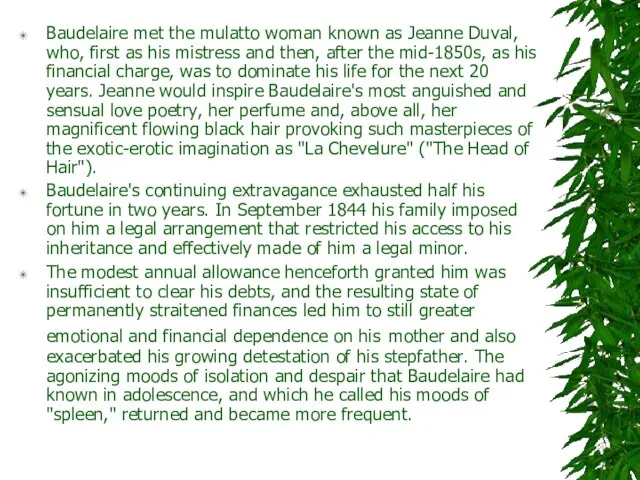
Baudelaire's continuing extravagance exhausted half his fortune in two years. In September 1844 his family imposed on him a legal arrangement that restricted his access to his inheritance and effectively made of him a legal minor.
The modest annual allowance henceforth granted him was insufficient to clear his debts, and the resulting state of permanently straitened finances led him to still greater emotional and financial dependence on his mother and also exacerbated his growing detestation of his stepfather. The agonizing moods of isolation and despair that Baudelaire had known in adolescence, and which he called his moods of "spleen," returned and became more frequent.
Слайд 15Les fleurs du mal (1857)
In its final version (1861), Les fleurs du
Les fleurs du mal (1857)
In its final version (1861), Les fleurs du
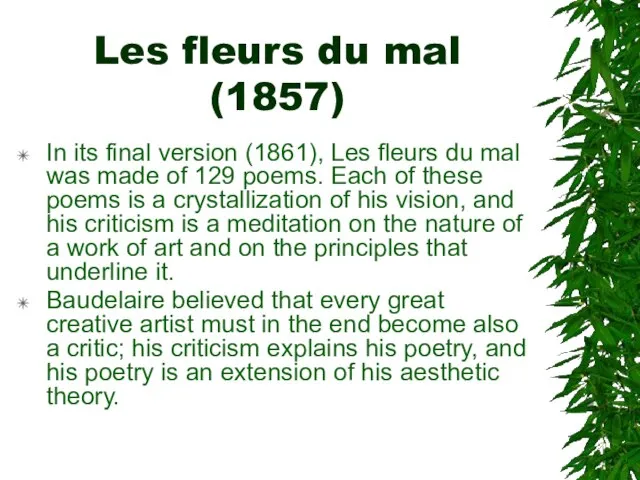
Baudelaire believed that every great creative artist must in the end become also a critic; his criticism explains his poetry, and his poetry is an extension of his aesthetic theory.
Слайд 16The failure of Les fleurs du mal, from which he had expected
The failure of Les fleurs du mal, from which he had expected
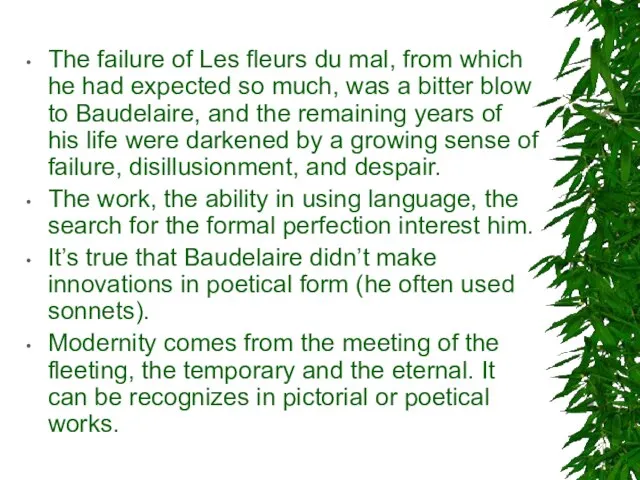
The work, the ability in using language, the search for the formal perfection interest him.
It’s true that Baudelaire didn’t make innovations in poetical form (he often used sonnets).
Modernity comes from the meeting of the fleeting, the temporary and the eternal. It can be recognizes in pictorial or poetical works.
Слайд 17Thanks to metaphor, the poet can establish some contacts among different elements.
Thanks to metaphor, the poet can establish some contacts among different elements.
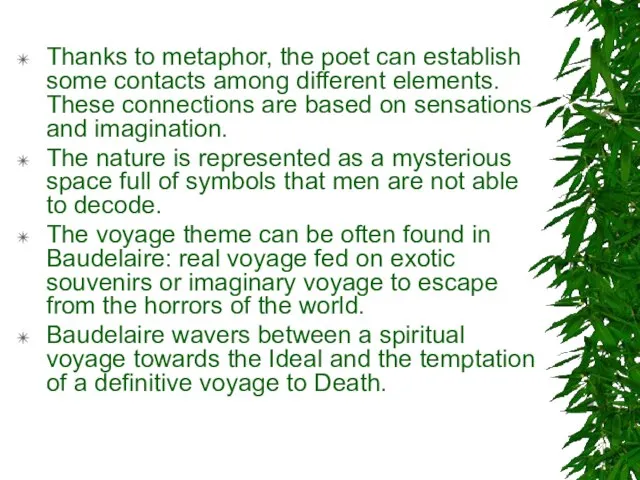
The nature is represented as a mysterious space full of symbols that men are not able to decode.
The voyage theme can be often found in Baudelaire: real voyage fed on exotic souvenirs or imaginary voyage to escape from the horrors of the world.
Baudelaire wavers between a spiritual voyage towards the Ideal and the temptation of a definitive voyage to Death.
Слайд 18Structure of “Les Fleurs du Mal”
“Spleen et Ideal”: men become aware of
Structure of “Les Fleurs du Mal”
“Spleen et Ideal”: men become aware of
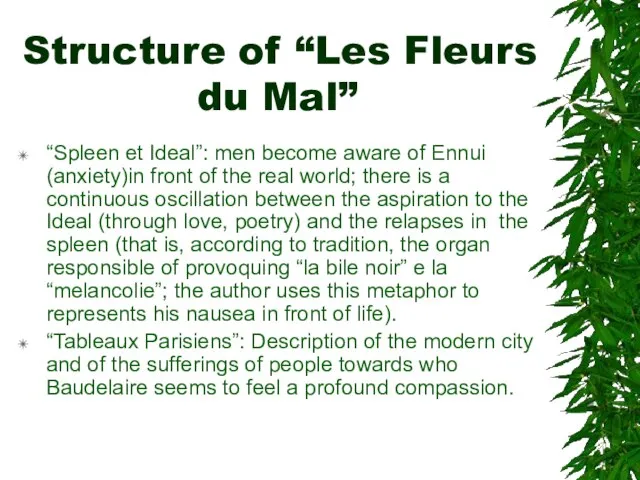
“Tableaux Parisiens”: Description of the modern city and of the sufferings of people towards who Baudelaire seems to feel a profound compassion.
Слайд 19“Le vin”: Escape in drunkenness.
“Les Fleurs du mal”: Escape in the artificial
“Le vin”: Escape in drunkenness.
“Les Fleurs du mal”: Escape in the artificial
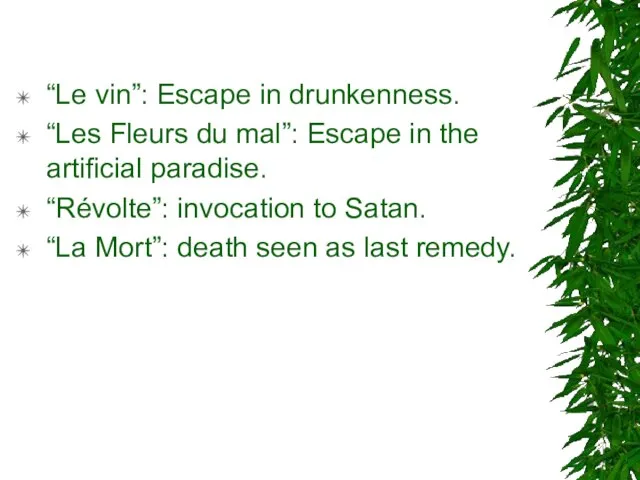
“Révolte”: invocation to Satan.
“La Mort”: death seen as last remedy.
Слайд 20Beauty
Conceive me as a dream of stone:
my breast, where mortals come
Beauty
Conceive me as a dream of stone: my breast, where mortals come
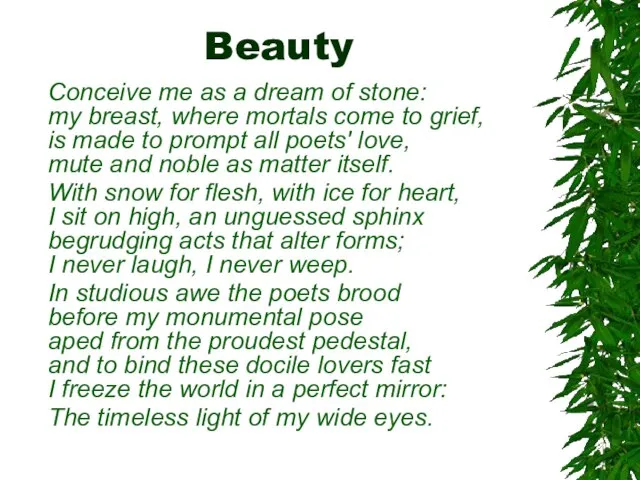
With snow for flesh, with ice for heart, I sit on high, an unguessed sphinx begrudging acts that alter forms; I never laugh, I never weep.
In studious awe the poets brood before my monumental pose aped from the proudest pedestal, and to bind these docile lovers fast I freeze the world in a perfect mirror:
The timeless light of my wide eyes.
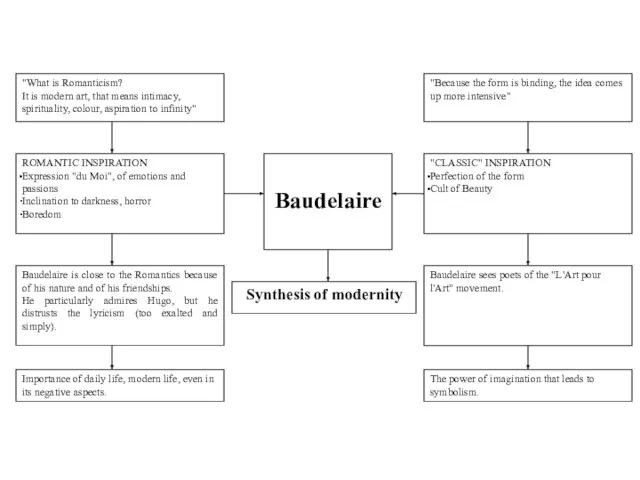
 ОАО “Мосэнерго” - крупнейшая энергетическая компания в Европе.
ОАО “Мосэнерго” - крупнейшая энергетическая компания в Европе. Компания по созданию журналов
Компания по созданию журналов Малая Академия Наук Украины Харцызский Городской Лицей N°2
Малая Академия Наук Украины Харцызский Городской Лицей N°2 ИНФОРМАЦИОННАЯ СИСТЕМА ДЛЯ АНАЛИЗА ИНФОРМАЦИИ О ГОСУДАРСТВЕННЫХ И МУНИЦИПАЛЬНЫХ ТОРГАХ НА РЕАЛИЗАЦИЮ (ПРОДАЖУ) ФЕДЕРАЛЬНОГО ИМУ
ИНФОРМАЦИОННАЯ СИСТЕМА ДЛЯ АНАЛИЗА ИНФОРМАЦИИ О ГОСУДАРСТВЕННЫХ И МУНИЦИПАЛЬНЫХ ТОРГАХ НА РЕАЛИЗАЦИЮ (ПРОДАЖУ) ФЕДЕРАЛЬНОГО ИМУ Формирование информационной культуры
Формирование информационной культуры Тренажёр имя существительное
Тренажёр имя существительное Программирование
Программирование  Муниципальное общеобразовательное учреждение средняя общеобразовательная школа №14 Мурманская область город Мончегорск
Муниципальное общеобразовательное учреждение средняя общеобразовательная школа №14 Мурманская область город Мончегорск Тренажёр по русскому Родственные слова
Тренажёр по русскому Родственные слова Что такое систематика
Что такое систематика Подготовка к научному проекту
Подготовка к научному проекту  Технологии образования в глобальном информационном сообществе (ТОГИС)
Технологии образования в глобальном информационном сообществе (ТОГИС) Решение задач BI и BAM на платформе InterSystems Ensemble
Решение задач BI и BAM на платформе InterSystems Ensemble 4
4 Презентация учителя истории сш. № 59 Лещенко Лидии Андреевны
Презентация учителя истории сш. № 59 Лещенко Лидии Андреевны Подземные воды и водохранилища
Подземные воды и водохранилища Интегрированные CAD/CAM-системы и управление станками с ЧПУ
Интегрированные CAD/CAM-системы и управление станками с ЧПУ Исследование потенциала гуманитарного и технического ума
Исследование потенциала гуманитарного и технического ума Применение современных компьюторных технологий на уроках физики
Применение современных компьюторных технологий на уроках физики Устройство светового микроскопа
Устройство светового микроскопа Орнамент и декоративно-прикладное искусство
Орнамент и декоративно-прикладное искусство Охрана труда Тема 1
Охрана труда Тема 1 Аралым
Аралым БИЦИКЛИЧЕСКИЕ ТЕРПЕНОВЫЕ ДИОЛЫ КАК ЛИГАНДЫ ДЛЯ СИНТЕЗА ХИРАЛЬНЫХ КАТАЛИЗАТОРОВ
БИЦИКЛИЧЕСКИЕ ТЕРПЕНОВЫЕ ДИОЛЫ КАК ЛИГАНДЫ ДЛЯ СИНТЕЗА ХИРАЛЬНЫХ КАТАЛИЗАТОРОВ Украина и украинцы
Украина и украинцы Использование этнокультурного компонента в работе воспитателя
Использование этнокультурного компонента в работе воспитателя Контроль знаний с помощью тестирования
Контроль знаний с помощью тестирования Кластеризация
Кластеризация